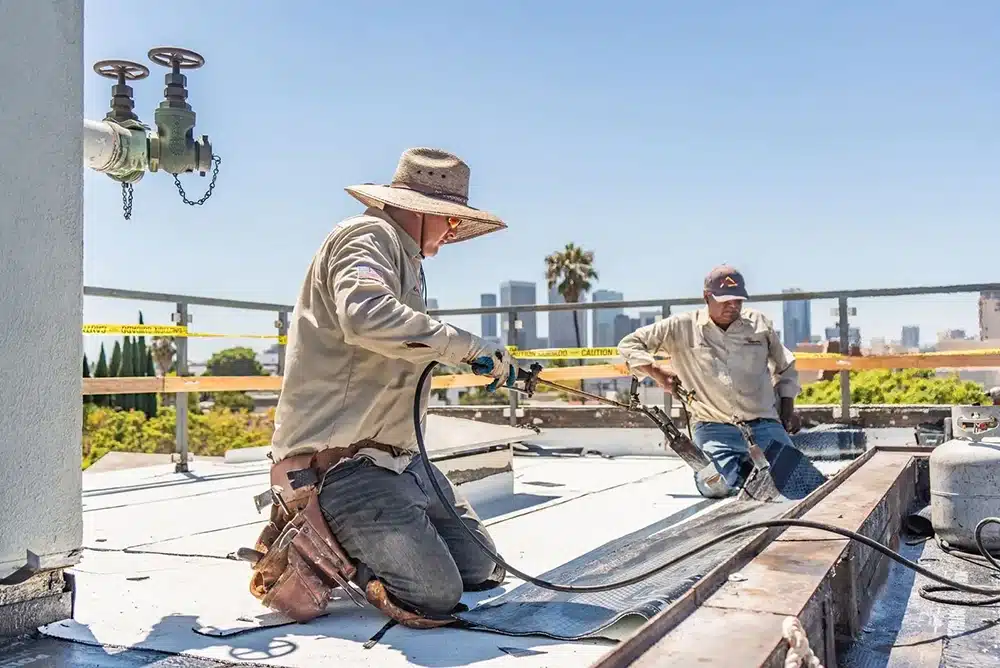Commercial property owners and managers in Southern California face a critical decision when addressing roof problems: should you replace the roof entirely or restore the existing system? Both options carry implications for cost, compliance, longevity, and the day-to-day operations of your tenants. The best choice depends on the condition of the current roof, the property’s business priorities, and the unique climate factors in Los Angeles, Ventura, and Orange Counties.
Key Differences Between Replacement and Restoration
- Roof Replacement involves removing the existing roofing system down to the deck and installing a new system. This option resets the roof’s life expectancy and ensures compliance with all current building codes.
- Roof Restoration typically includes cleaning, repairing localized damage, and applying a coating system over the existing membrane. Restoration extends the service life of the roof without a complete tear-off, provided the roof is structurally sound.
Replacement is a capital expenditure, while restoration is often treated as maintenance—affecting how each investment is recorded and budgeted.
Cost Comparison for Southern California Properties
In Southern California, the cost of commercial roof replacement can range from $8 to $14 per square foot, depending on the system type and building complexity. Restoration, by contrast, is significantly lower—often $3 to $6 per square foot. For large industrial facilities or multi-unit properties, the cost savings of restoration can be substantial.
However, restoration is only viable if the existing roof still has structural integrity. If widespread saturation or deck failure is present, replacement is the only safe and code-compliant option.
Business Impact and Tenant Disruption
Roof replacement typically requires a full tear-off, which results in increased noise, dust, debris, and potential disruption for building occupants. Depending on the property type—such as hospitals, retail centers, or apartment communities—this can affect business operations and tenant satisfaction.
Roof restoration typically has a much lighter footprint. Coatings and repairs can be applied with minimal interruption, often allowing businesses to continue operating without disruption.
Longevity and Performance in Southern California Climates
Southern California’s climate presents unique challenges: intense sun exposure, seasonal rains, and occasional Santa Ana winds. A new roof system provides 20 to 30 years of protection when properly maintained. Restoration systems typically extend a roof’s life by 8 to 15 years, depending on the type of coating and the maintenance schedule.
For owners considering long-term property holds, replacement may be the better investment. For those seeking to maximize value in the medium term, restoration provides strong performance at a lower upfront cost.
Energy Efficiency and Sustainability
Reflective “cool roof” systems, as required under California Title 24, can reduce HVAC loads and lower energy bills. Both replacement and restoration can achieve compliance:
- Replacement allows full integration of energy-efficient materials and insulation.
- Restoration coatings can upgrade reflectivity and help reduce heat gain without a full tear-off.
From a sustainability perspective, restoration reduces landfill waste by reusing the existing system, making it an environmentally responsible choice.
Warranty Coverage and Long-Term Protection
- Replacement warranties often range from 20 to 30 years, depending on the manufacturer and system installed.
- Restoration warranties are typically 10 to 15 years in length, covering both the material and workmanship of the coating.
Warranty coverage can be a decisive factor if you manage properties with long-term lease obligations or if tenants require extended guarantees for building performance.
Building Code Compliance in LA, Ventura, and Orange Counties
Local jurisdictions require that roofs meet current building codes, including Title 24 energy requirements and seismic considerations. Replacement ensures full compliance, particularly if your building requires upgraded insulation or structural reinforcement. Restoration is generally acceptable provided the existing roof system is structurally sound and not beyond allowable layers.
Insurance Implications and Potential Savings
Insurance carriers may offer favorable terms when a roof is replaced with a code-compliant system. A restored roof can also improve insurability by addressing leaks and prolonging the system’s life, although the shorter warranty period may limit some coverage benefits. In both cases, documenting the work with a professional roofing contractor helps ensure future claims are supported.
When Restoration is Viable—and When It’s Not
Restoration is best suited when:
- The roof is structurally sound.
- Moisture intrusion is limited and isolated.
- The membrane has not reached the end of its serviceable life.
- Budget priorities favor extending life rather than full replacement.
Replacement is necessary when:
- There is extensive water damage or saturated insulation.
- Multiple roof layers exceed code limits.
- The deck or structure is compromised.
- Long-term investment stability is a priority.
Return on investment for Property Owners and Managers
Property decision-makers must strike a balance between short-term savings and long-term asset value.
- Replacement provides the longest service life, highest warranty coverage, and maximum compliance assurance, protecting the asset for decades.
- Restoration delivers cost savings, minimal tenant disruption, and sustainability benefits, making it a strategic choice when the roof qualifies.
In Southern California’s competitive real estate market, aligning roof strategy with business objectives, lease terms, and long-term ownership goals ensures the best return on investment.
Conclusion
At SBR Roofing, we assist property managers, owners, and HOAs in evaluating the condition of their roof systems and determining whether restoration or replacement offers the best value. With over sixty years of experience in Southern California, we offer informed, long-term solutions that protect both your property and your financial interests.







